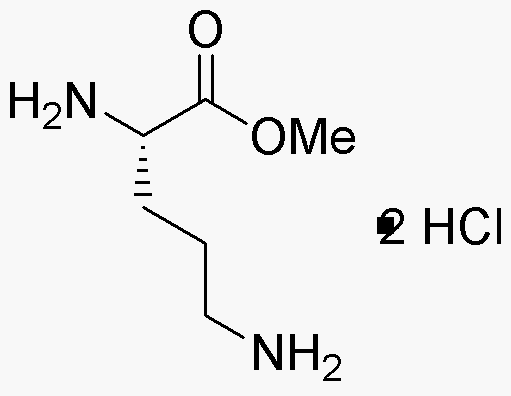L-Ornithine methyl ester dihydrochloride is widely utilized in research focused on:
- Nutrition and Dietary Supplements: This compound is often used in formulations aimed at enhancing athletic performance and recovery, as it plays a role in the urea cycle and can help reduce ammonia levels in the body.
- Pharmaceuticals: It serves as a precursor in the synthesis of various pharmaceuticals, particularly those targeting metabolic disorders, due to its ability to influence nitrogen metabolism.
- Cosmetics and Skincare: The compound is incorporated into cosmetic products for its potential to improve skin hydration and elasticity, making it appealing for anti-aging formulations.
- Research in Biochemistry: It is used in laboratory studies to investigate metabolic pathways, particularly in studies related to amino acid metabolism and cellular function.
- Animal Feed Additives: L-Ornithine methyl ester dihydrochloride is added to animal feed to promote growth and improve feed efficiency, benefiting the livestock industry.
General Information
Properties
Safety and Regulations
Applications
L-Ornithine methyl ester dihydrochloride is widely utilized in research focused on:
- Nutrition and Dietary Supplements: This compound is often used in formulations aimed at enhancing athletic performance and recovery, as it plays a role in the urea cycle and can help reduce ammonia levels in the body.
- Pharmaceuticals: It serves as a precursor in the synthesis of various pharmaceuticals, particularly those targeting metabolic disorders, due to its ability to influence nitrogen metabolism.
- Cosmetics and Skincare: The compound is incorporated into cosmetic products for its potential to improve skin hydration and elasticity, making it appealing for anti-aging formulations.
- Research in Biochemistry: It is used in laboratory studies to investigate metabolic pathways, particularly in studies related to amino acid metabolism and cellular function.
- Animal Feed Additives: L-Ornithine methyl ester dihydrochloride is added to animal feed to promote growth and improve feed efficiency, benefiting the livestock industry.
Documents
Safety Data Sheets (SDS)
The SDS provides comprehensive safety information on handling, storage, and disposal of the product.
Product Specification (PS)
The PS provides a comprehensive breakdown of the product’s properties, including chemical composition, physical state, purity, and storage requirements. It also details acceptable quality ranges and the product's intended applications.
Certificates of Analysis (COA)
Search for Certificates of Analysis (COA) by entering the products Lot Number. Lot and Batch Numbers can be found on a product’s label following the words ‘Lot’ or ‘Batch’.
*Catalog Number
*Lot Number
Certificates Of Origin (COO)
This COO confirms the country where the product was manufactured, and also details the materials and components used in it and whether it is derived from natural, synthetic, or other specific sources. This certificate may be required for customs, trade, and regulatory compliance.
*Catalog Number
*Lot Number
Safety Data Sheets (SDS)
The SDS provides comprehensive safety information on handling, storage, and disposal of the product.
DownloadProduct Specification (PS)
The PS provides a comprehensive breakdown of the product’s properties, including chemical composition, physical state, purity, and storage requirements. It also details acceptable quality ranges and the product's intended applications.
DownloadCertificates of Analysis (COA)
Search for Certificates of Analysis (COA) by entering the products Lot Number. Lot and Batch Numbers can be found on a product’s label following the words ‘Lot’ or ‘Batch’.
*Catalog Number
*Lot Number
Certificates Of Origin (COO)
This COO confirms the country where the product was manufactured, and also details the materials and components used in it and whether it is derived from natural, synthetic, or other specific sources. This certificate may be required for customs, trade, and regulatory compliance.


